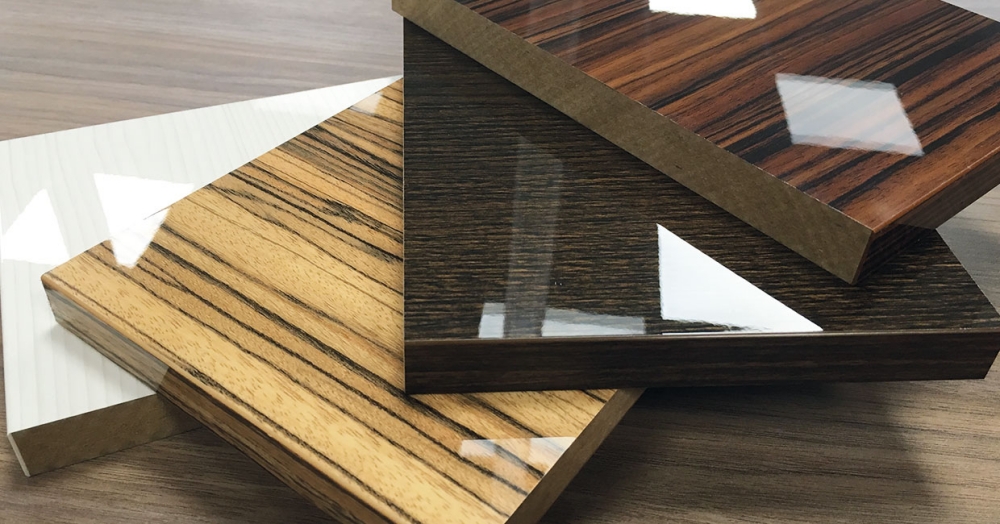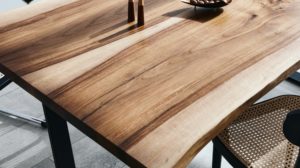Achieving that perfect sheen, where the surrounding images are reflected like a mirror, is one of the challenges of finishing wooden surfaces or MDFeven in experienced factories. Gloss depends not only on the quality of the varnish but also on many other conditions that must be met. Each condition has its part to play in achieving the perfect glossy surface and one without the other is not enough. I'm not a fan of gloss and when asked for advice, not infrequently my recommendation is the matte finish. Because gloss finish is also very hard to maintain not just achieve. But I have to admit that there have been times when the gloss has been so appropriate and perfectly chosen that it has won me over. That's why I think it would be useful to have a list of the conditions that need to be met to result in a surface with a perfect gloss.

1. The place where finishing is done must be dust-free and at a suitable temperature
The biggest enemy of gloss is dust. You cannot achieve a mirror-like gloss and a surface that is pleasant to the touch if there is a lot of dust in the space where the varnish is applied or if you are mechanically working on wooden surfaces. Small dust particles trapped in the film are seen much larger, like small craters, because they are magnified by the gloss lacquer.
If you have a workshop, find a separate space to apply the varnish, different from the one where the mechanical work is done. If this is not possible, apply the varnish on a different day to the day on which the machining was done and after you have cleaned the workshop by removing wood debris. Wet down with water as water attracts dust particles from the atmosphere. Do not start painting immediately after cleaning. Allow the dust to settle overnight and then wet the floor again in the morning.
To those in factories I recommend pressurised spray booths. Spraying is done in enclosed spaces where there is slightly more pressure than outside. This prevents outside dust particles from being drawn in. Drying of the film is also done in these spaces because the lake is vulnerable as long as it is wet. Cabins can be bought, or spaces can be set up in which the air recirculation is calculated in such a way that there is always a small excess pressure inside. The change in the volume of air in the enclosure does not have to be rapid because currents can occur that produce small ripples in the wet film that will affect the final gloss.
Temperature is also important. The optimum working temperature is between 18 and 20°C. It won't be a tragedy if the temperature is a little higher or lower, but if the varnish is applied at 10 or 35°C, you will not achieve perfect surfaces. Also bear in mind that this temperature refers not only to the workshop but also to the wood or varnish. There is no point in having 20°C in the workshop if the wood or varnish is brought in from an unheated warehouse just before you start applying. A cold varnish or lacquer will not spread well on the surface of the wood or wood-derived boards and you will not achieve the desired gloss.
2. The surface to be primed and varnished/painted must be very well prepared
Before applying the finish, prepare the surface thoroughly. It must be very well polished, without bumps, holes or other defects. Remember, gloss magnifies any defects. If the application is on solid wood or veneered boards, sanding should be done at the end with sandpaper not too coarse because the rhizomes left after sanding may become visible with a gloss varnish on top. You can finalize with 180 or 220, even 240. Finer sanding may lead to a decrease in adhesion of the primer.
After sanding, remove the remaining dust thoroughly with a cloth. If a blower is used, do not apply the primer in the space where the fine wood dust has been blown. If using wet rags, do not use water if you are going to apply solvent-based materials but the solvent of the primer.
If you're going to apply the finish to MDF panels, make sure you have a quality, dense panel with no small holes that release air when the primer is absorbed. This air gets trapped in the film and forms small holes in the film that are difficult to remove when sanding. Use insulator for milled areas - less primer will be absorbed and the wood fibers in the panel will lift less, making sanding easier.

3. The primer coat should not be very thin and sanding should result in a very smooth surface
To have a mirror sheen, the varnish must be applied on a very smooth surface. To achieve such a surface, the primer must be very well polished. A good sanding is obtained by making several passes with the sanding paper over the sanded surface. This is why a hard and thicker coat of primer is needed. Generally 2-3 coats of good quality primer are applied. There are areas (such as coffins, where gloss is a basic requirement) where up to 4 coats of primer are applied.
Those who achieve very glossy surfaces use polyurethane or even polyester primers because they are hard and have a large body (the solid substance that remains after the solvent evaporates). They do not apply one very thick coat but several thin ones. In thick layers, stresses build up and there is a high risk of cracking.
Sanding should be done at least after the first coat of primer - to remove high fibers - and before varnish application. Ideally, sand after each coat of primer. Sanding removes film imperfections (orange peel effect), dust particles trapped on the surface and small cracks left by trapped air. Do not use sandpaper below 400 because the small scratches that occur during sanding will be visible through the gloss varnish layer.
4. The varnish chosen should be high gloss and of good quality
Good quality varnishes do not dry quickly and spread very well on the primed surface. The drying time is longer precisely to give the varnish time to set so that the surface is perfectly smooth and the light reflection is total. Do not force dry glossy varnishes, you will not get a quality product.
High gloss means gloss above 90, even 95 gloss. Find here information on the classification of varnishes in terms of gloss. Good quality glossy varnishes also have a very good transparency which emphasizes that feeling of perfect gloss.
5. For a deep sheen, the varnish should be thicker
The general recommendation when finishing is to apply several coats of primer and only one coat of varnish. It is the varnish that gives the surface qualities of the varnish - hardness, scratch resistance, abrasion resistance, resistance to hot or cold liquids, staining - and one coat of varnish is sufficient to give the surface these qualities.
For the gloss finish, however, it is recommended to apply 2 coats of varnish, 30-45 minutes apart, without sanding. This creates a thicker coat of varnish which gives the finish depth. If the varnish also has very good transparency, the effect is of a very clear and very misty calm sea. The lightness and depth will emphasize the natural design of the wood.
In the case of painted MDF, in order to achieve this depth, a transparent gloss varnish is applied over the paint. In addition to this effect, the lacquer also provides very good protection. In the case of fine scratches, only the lacquer will be removed, not the paint, and the defect will be barely visible.
6. The equipment used should apply uniform quantities and incorporate as little air as possible in the film
The application of finishing materials is usually done with spray guns. This method introduces air into the film. Sometimes this air doesn't have time to escape and gets trapped in the film, giving a rough look and spoiling the gloss. The less air entrapped application systems are used, the better the finish will look.
7. Sometimes, even if all the rules are followed, polishing is still needed
It is not easy to fulfill all the above conditions. Often, despite the best efforts, the images are not perfectly reflected by the surfaces obtained or small particles remain trapped on the surface. Perfection can still be achieved by polishing the surface with very fine abrasive pastes.
Find details on how to get polished here. What I want to emphasize is that you need some experience to get very good quality surfaces. It is not impossible to do and you don't need special courses to do it. Improvement comes, however, over time, after you've done it a few times and you've caught the little secrets.
Much can be said about the gloss finish and the risk of getting lost in the details is great. That's why I prefer to stop here. I would be happy if you would leave in the dedicated space all your unanswered questions or any questions of clarification. I promise to reply to each of you.

































Thanks for the detailed and informative articles!
Thank you too for following us!
Great articles, including this one! And a question: for MDF, what brand of paint and varnish do you recommend? Thanks in advance for the answer
Good evening!
For best results use professional products. That means primer and varnish from companies such as Sirca, Ica (Lomilux), Sayerlack (Golda), Milesi, Renner, Remmers, etc. Contact the distributors of these products and ask for application instructions. If you follow them, the results will be outstanding.
Good luck!